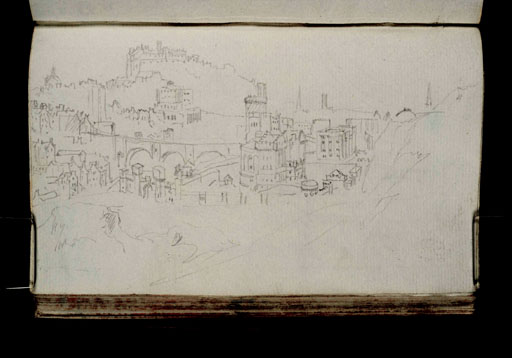Joseph Mallord William Turner Edinburgh, from Calton Hill 1818
Image 1 of 2
Joseph Mallord William Turner,
Edinburgh, from Calton Hill
1818
Joseph Mallord William Turner 1775–1851
Folio 61 Verso:
Edinburgh, from Calton Hill 1818
D13430
Turner Bequest CLXV 59a
Turner Bequest CLXV 59a
Pencil on white laid paper, 99 x 159 mm
Accepted by the nation as part of the Turner Bequest 1856
References
1909
A.J. Finberg, A Complete Inventory of the Drawings of the Turner Bequest, London 1909, vol.I, p.480, CLXV 59a, as ‘Edinburgh, from Calton Hill.’.
As Walter Scott pointed out, this view of Edinburgh from Calton Hill is ‘one of the most magnificent scenes in this romantic city’,1 and it is one that Turner made many times. He exhibited a watercolour of the scene at the Royal Academy in 1804, following his visit to Edinburgh in 1801 (Edinburgh from Calton Hill, Tate D03639, Turner Bequest LX H), and made several sketches in this sketchbook (folio 53 verso; D13414; CLXV 51a).
A similar view, presumable made on the same occasion as this one, is drawn over two pages of the Scotch Antiquities book (Tate D13651, D13652; Turner Bequest CLXVII 39a, 40). This was the sketch on which Turner based his design for the Provincial Antiquities illustration: Edinburgh from Calton Hill, circa 1819 (watercolour, National Gallery of Scotland).2 The view here, however, is made slightly to the left (west) of the Scotch Antiquities drawing, as is evinced by the relative positions of North Bridge and Edinburgh Castle.
This relatively finished drawing, compared to others in the sketchbook, shows the edge of the Calton Hill in the foreground to the right of the page and at the bottom. We look north towards the castle with North Bridge beneath it, joining the Old Town to the left and the New Town to the right where we see some of the buildings on Princes Street. To the left of the castle, in the right place but exaggerated in size, is the spire of St Giles’s Cathedral on the High Street. On the right of the picture is Calton Gaol.
The view is very similar to that of Turner’s watercolour, Edinburgh Castle: March of the Highlanders (1836, Tate N04953, Turner Bequest) which was engraved for Fisher’s Illustrations to the Waverley Novels of Sir Walter Scott in 1836. Although Turner had sketched the view from Calton Hill repeatedly since 1801, this sketch perhaps comes closest to the final design. However, Turner compressed the view in every direction, fitting hundreds of tartan-clad highlanders into the foreground and bringing the castle, and Calton Hill, with North Bridge in the middle, closer together.
In 1822, Turner witnessed the event that is depicted in March of the Highlanders, the procession to Calton Hill on the occasion of the laying of the foundation stone of the National Monument. A sketch in the King’s Visit to Edinburgh, 1818 sketchbook relates to this event and provides a similar view which also contributed the design (Tate D17563–D17564; Turner Bequest CC 35a–36).
Thomas Ardill
November 2007
How to cite
Thomas Ardill, ‘Edinburgh, from Calton Hill 1818 by Joseph Mallord William Turner’, catalogue entry, November 2007, in David Blayney Brown (ed.), J.M.W. Turner: Sketchbooks, Drawings and Watercolours, Tate Research Publication, December 2012, https://www


